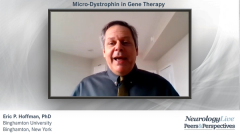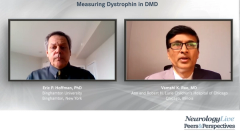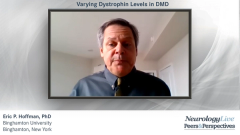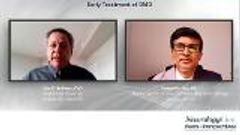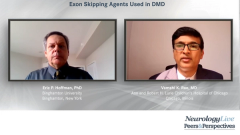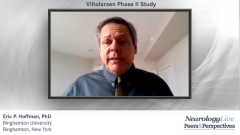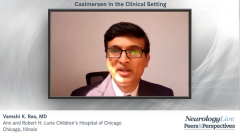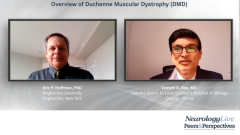
Overview of Duchenne Muscular Dystrophy (DMD)
Vamshi K. Rao, MD, and Eric P. Hoffman, PhD, review Duchenne muscular dystrophy and the mutations involved.
Episodes in this series

Vamshi K. Rao, MD: Hello, and thank you for joining this Neurology Live® Peers & Perspectives® presentation titled “Dystrophin and its Role in Effective Treatment of Duchenne Muscular Dystrophy.” Today we are going to discuss how dystrophin relates to Duchenne muscular dystrophy, approved therapies, as well as treatments and development. I’m Dr Vamshi K. Rao, an attending neurologist at the Ann and Robert H. Lurie Children’s Hospital of Chicago and an assistant professor in pediatrics at the Northwestern University Feinberg School of Medicine in Chicago, Illinois. Joining me is Eric P. Hoffman, an associate dean for research in the School of Pharmacy and Pharmaceutical Sciences at Binghamton University in Binghamton, New York. Dr Hoffman is also a cofounder and involved in the management of ReveraGen BioPharma, AGADA Biosciences, and TRiNDS, LLC. Thank you so much for joining us. Hello, Dr Hoffman.
Eric P. Hoffman, PhD: Hi, Dr Rao. It’s a pleasure to be here with you.
Vamshi K. Rao, MD: Likewise. Let’s start by talking about the cause of Duchenne muscular dystrophy.
Eric P. Hoffman, PhD: Duchenne muscular dystrophy is 1 of the most common genetic diseases worldwide. It’s on the X chromosomes. It’s X-linked recessive, meaning predominantly boys get the disease. Mothers can be carriers, but there’s a very high new mutation rate of the gene, so many mothers are not carriers. It’s just a mutation in an egg that leads to a child with Duchenne muscular dystrophy. The very high mutation rate is now understood. It’s all tied to the gene and the mutations involved, which is the DMD gene on the X chromosome, the largest gene ever identified. A typical gene is about 30,000 base pairs, or letters—which is like 1 recipe in The Joy of Cooking.
The DMD gene is 100 times bigger. It’s 2.3 million base pairs. Because it’s so large, it’s a high target for mutation. It’s like hitting the side of a barn with a baseball. It has a very high mutation rate. The types of mutations are often missing pieces, deletions, or duplications. Most patients have a private mutation. Many of the mutations are distributed throughout this enormous gene. In Duchenne muscular dystrophy, the mutations knock out the function of the gene. In knocking out its function, it can’t make the protein product, which is normally dystrophin. Dystrophin is a component of skeletal muscle, heart visceral smooth muscle, vascular smooth muscle, peripheral nerve, and some neurons. When this gene is knocked out by a mutation, that protein is missing from all those tissues in a patient from fetal life onward. Dystrophin deficiency is the cause of Duchenne muscular dystrophy.
Vamshi K. Rao, MD: As I understand, the incidence in children is predicted to be between 1 in 3500 and 1 in 5000. There are female carriers, but there are also women with dystrophinopathy, which I believe can manifest symptoms. Dystrophin is in the brain, along with all the other tissues that you mentioned. There’s always the question of how dystrophin functions in the brain. We do know that there are some children, almost one-fifth, who can have an autism-like phenotype along with the Duchenne muscular dystrophy.
Eric P. Hoffman, PhD: The gene is very complicated. It is normally expressed in these different tissues and there are different types of dystrophin protein in each tissue. It’s clear that the mutations and loss of dystrophin initiates the disease process, but how the different tissues respond as a function of age is unclear. Visceral and vascular smooth muscle is not a primary component of the pathology, but it’s probably there and contributing to it, along with the brain.
We have found animal models that have mutations of the same gene that occur spontaneously. Dozens of breeds of dogs and cats have mutations of the same gene because of the same high mutation rate. A lot of those phenotypes, the different involvements of the different tissues, vary between the animals as well. You’re right that the brain seems to be more affected in some patients than others. In mice, some experiments suggest that might be because of ischemic episodes. Dystrophin deficiency might be particularly susceptible to ischemic insults, and that may be upstream of this variability and brain involvement.
Vamshi K. Rao, MD: I thank all of you for watching this Neurology Live® Peers & Perspectives®. If you enjoyed the content, please subscribe to our newsletters to receive upcoming programs and other great content in your in-box. Thank you.
Transcript Edited for Clarity
Newsletter
Keep your finger on the pulse of neurology—subscribe to NeurologyLive for expert interviews, new data, and breakthrough treatment updates.

